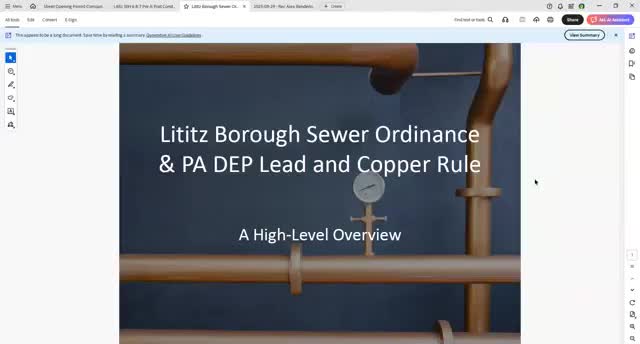Lititz Borough staff brief council on sewer cleanouts and lead-service‑line inventory
September 30, 2025 | Lititz Borough, Lancaster County, Pennsylvania
This article was created by AI summarizing key points discussed. AI makes mistakes, so for full details and context, please refer to the video of the full meeting. Please report any errors so we can fix them. Report an error »

Rob, a public-works staff member, told the council that borough ordinance language drawn in 1963 establishes the typical ownership demarcation for sewer laterals: the homeowner is generally responsible from the house to the curb, and the borough is responsible from the curb to the sewer main in the street. "Basically, for the sewer side, the homeowner is responsible from the house the whole way out to the curb, and then from the curb out to the main sewer line in the street is the responsibility of the borough," Rob said.
Rob and other staff focused council attention on two issues: (1) missing or damaged sewer cleanout caps at the curb, which allow public-works crews to clear blockages and prevent stormwater inflow; and (2) the borough’s continuing inventory of water service-line materials to comply with state and federal lead‑service-line rules. Rob said public works has identified roughly 50–100 curb cleanouts without caps when crews looked from the street, and the department is inventorying missing caps so the borough can consider making caps available or pursue ordinance changes to clarify repair responsibilities.
On water service-line material, Rob said the borough has about 4,500 water connections. He reported the inventory counts submitted to the Pennsylvania Department of Environmental Protection as of Aug. 1: 591 confirmed non-lead service lines, 207 galvanized lines requiring replacement, and 3,104 service lines listed as "unknown" pending verification. Rob said the unknown category largely reflects the verification process the borough must complete; staff believe many of the unknowns will prove to be copper once verified.
Rob explained the regulatory context: the federal Environmental Protection Agency and the Pennsylvania Department of Environmental Protection require communities to inventory and replace service lines that contain lead or have a portion of lead. Borough staff said grant or low-interest loan programs such as PENNVEST have helped similar projects in the past, but such funding often carries program-management burdens and is not guaranteed.
Council members and residents asked practical questions about when homeowners are required to replace their portion of a service line and whether the borough will assist with costs. Rob said the homeowner is responsible for replacing the private portion of a lead service line; the borough will seek grant funding when possible but does not have a universal slush fund to cover private-owner replacements. He urged residents to report their service-line material to borough staff and to send the photos or paperwork requested in recent mailings to help the inventory effort.
The presentation was for information; council did not take an action to change policy at the meeting.
Rob and other staff focused council attention on two issues: (1) missing or damaged sewer cleanout caps at the curb, which allow public-works crews to clear blockages and prevent stormwater inflow; and (2) the borough’s continuing inventory of water service-line materials to comply with state and federal lead‑service-line rules. Rob said public works has identified roughly 50–100 curb cleanouts without caps when crews looked from the street, and the department is inventorying missing caps so the borough can consider making caps available or pursue ordinance changes to clarify repair responsibilities.
On water service-line material, Rob said the borough has about 4,500 water connections. He reported the inventory counts submitted to the Pennsylvania Department of Environmental Protection as of Aug. 1: 591 confirmed non-lead service lines, 207 galvanized lines requiring replacement, and 3,104 service lines listed as "unknown" pending verification. Rob said the unknown category largely reflects the verification process the borough must complete; staff believe many of the unknowns will prove to be copper once verified.
Rob explained the regulatory context: the federal Environmental Protection Agency and the Pennsylvania Department of Environmental Protection require communities to inventory and replace service lines that contain lead or have a portion of lead. Borough staff said grant or low-interest loan programs such as PENNVEST have helped similar projects in the past, but such funding often carries program-management burdens and is not guaranteed.
Council members and residents asked practical questions about when homeowners are required to replace their portion of a service line and whether the borough will assist with costs. Rob said the homeowner is responsible for replacing the private portion of a lead service line; the borough will seek grant funding when possible but does not have a universal slush fund to cover private-owner replacements. He urged residents to report their service-line material to borough staff and to send the photos or paperwork requested in recent mailings to help the inventory effort.
The presentation was for information; council did not take an action to change policy at the meeting.
View full meeting
This article is based on a recent meeting—watch the full video and explore the complete transcript for deeper insights into the discussion.
View full meeting